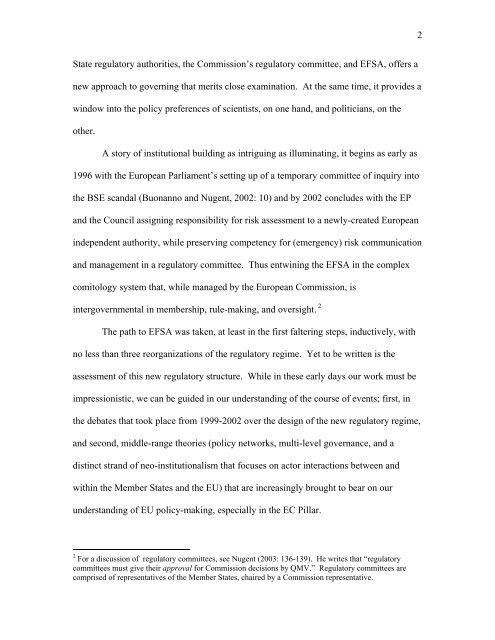POLITICS VERSUS SCIENCE: APPORTIONING ... - Buffalo State
POLITICS VERSUS SCIENCE: APPORTIONING ... - Buffalo State
POLITICS VERSUS SCIENCE: APPORTIONING ... - Buffalo State
Create successful ePaper yourself
Turn your PDF publications into a flip-book with our unique Google optimized e-Paper software.
<strong>State</strong> regulatory authorities, the Commission’s regulatory committee, and EFSA, offers a<br />
new approach to governing that merits close examination. At the same time, it provides a<br />
window into the policy preferences of scientists, on one hand, and politicians, on the<br />
other.<br />
A story of institutional building as intriguing as illuminating, it begins as early as<br />
1996 with the European Parliament’s setting up of a temporary committee of inquiry into<br />
the BSE scandal (Buonanno and Nugent, 2002: 10) and by 2002 concludes with the EP<br />
and the Council assigning responsibility for risk assessment to a newly-created European<br />
independent authority, while preserving competency for (emergency) risk communication<br />
and management in a regulatory committee. Thus entwining the EFSA in the complex<br />
comitology system that, while managed by the European Commission, is<br />
intergovernmental in membership, rule-making, and oversight. 2<br />
The path to EFSA was taken, at least in the first faltering steps, inductively, with<br />
no less than three reorganizations of the regulatory regime. Yet to be written is the<br />
assessment of this new regulatory structure. While in these early days our work must be<br />
impressionistic, we can be guided in our understanding of the course of events; first, in<br />
the debates that took place from 1999-2002 over the design of the new regulatory regime,<br />
and second, middle-range theories (policy networks, multi-level governance, and a<br />
distinct strand of neo-institutionalism that focuses on actor interactions between and<br />
within the Member <strong>State</strong>s and the EU) that are increasingly brought to bear on our<br />
understanding of EU policy-making, especially in the EC Pillar.<br />
2 For a discussion of regulatory committees, see Nugent (2003: 136-139). He writes that “regulatory<br />
committees must give their approval for Commission decisions by QMV.” Regulatory committees are<br />
comprised of representatives of the Member <strong>State</strong>s, chaired by a Commission representative.<br />
2












